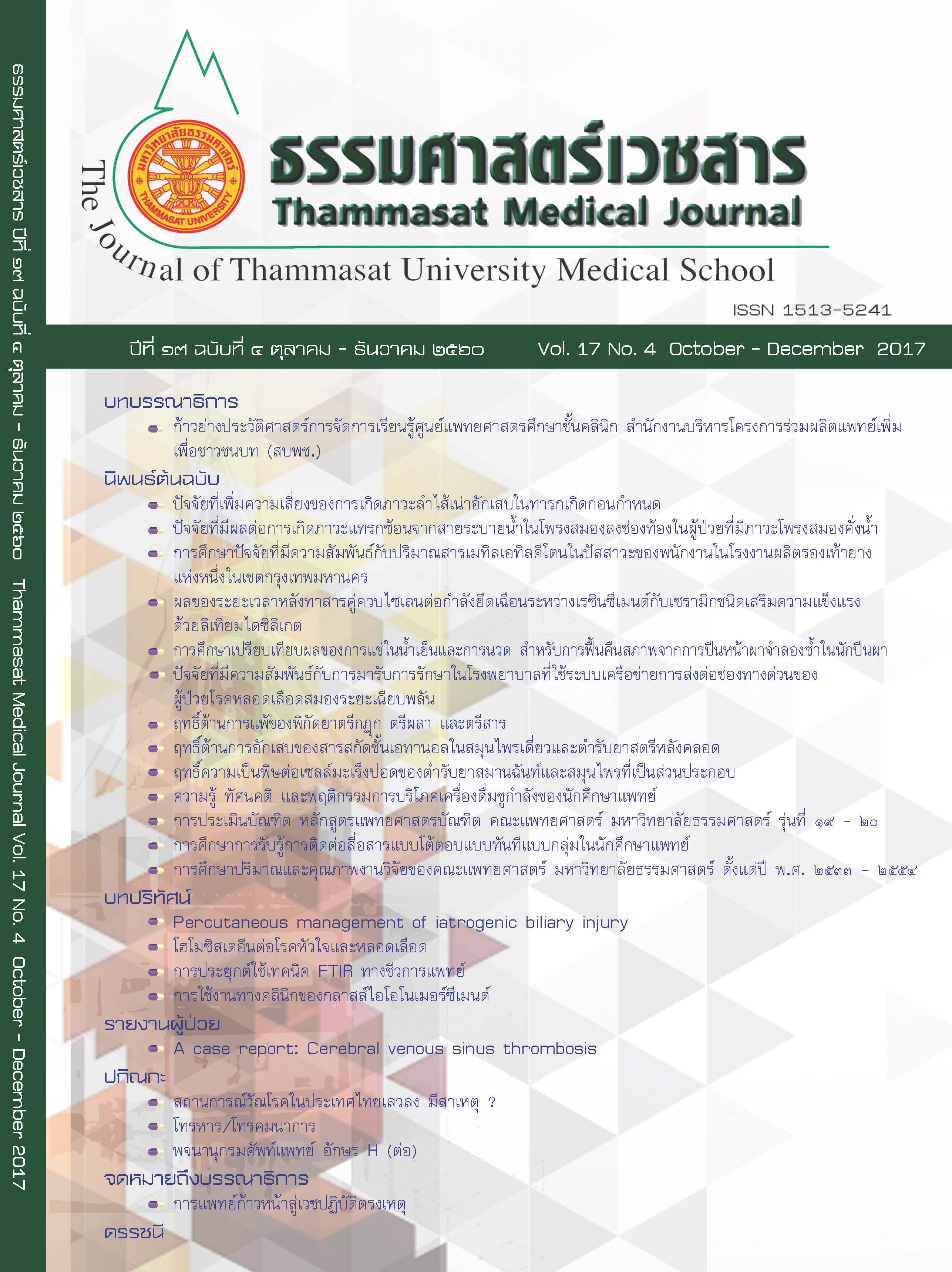The factors related to seeking treatment at a hospital using a stroke fast track referral network system with acute stroke patients
Keywords:
Acute stroke, Seeking treatment, Stroke fast track referral network system, โรคหลอดเลือดสมองระยะเฉียบพลัน, การมารับการรักษา, ระบบเครือข่ายการส่งต่อช่องทางด่วนAbstract
Introduction: Cerebrovascular disease is one of the important causes of death among the global population including Thai people. The stroke fast track referral network system was developed as a health care service for acute stroke patients.
Method: This study was a descriptive design, aimed at studying the factors related to seeking treatment at a hospital using a stroke fast track referral network system for acute stroke patients. The samples were comprised of 120 acute stroke patients that met the inclusion criteria. The tools were a demographic questionnaire, data from a referral network system, and perceived severity assessment and perceived warning signs assessment. The data were analyzed using descriptive statistics and Chi-square.
Result: The type of main server hospital, communication methods and perceived severity were found to be statistically significant related to seeking treatment at the hospital for the acute stroke patients (X2 = 5.19, 6.40, 7.33; p < 0.05). The total mean time used for seeking treatment of the patients was 199.43 minutes. (S.D. = 57.85)
Discussion and Conclusion: The factors related to the referral network system, education and creating stroke awareness among stroke patients, and family and care givers were important. Through this referral network system, acute stroke patients can access health care services, and receive prompt and effective treatment. Thus patients’ complications and, disabilities can be preventable and death rates can be reduced.
บทคัดย่อ
บทนำ: โรคหลอดเลือดสมองเป็นหนึ่งในสาเหตุการเสียชีวิตที่สำคัญของประชากรทั่วโลกรวมถึงประชากรไทย ระบบเครือข่ายการส่งต่อช่องทางด่วนเป็นระบบบริการสุขภาพที่พัฒนาเพื่อการดูแลผู้ป่วยโรคหลอดเลือดสมองระยะเฉียบพลัน
วิธีการศึกษา: การศึกษาครั้งนี้เป็นการวิจัยเชิงบรรยาย โดยมีวัตถุประสงค์เพื่อศึกษาปัจจัยที่มีความ สัมพันธ์กับการมารับการรักษาในโรงพยาบาลที่ใช้ระบบเครือข่ายการส่งต่อช่องทางด่วนของผู้ป่วยโรคหลอดเลือดสมองระยะเฉียบพลัน กลุ่มตัวอย่างเป็นผู้ป่วยโรคหลอดเลือดสมองที่มีคุณสมบัติตามเกณฑ์ที่กำหนด จำนวน ๑๒๐ ราย เครื่องมือที่ใช้ประกอบด้วย แบบบันทึกข้อมูลส่วนบุคคล แบบบันทึกข้อมูลเกี่ยวกับโรคและการช่วยเหลือ แบบบันทึกข้อมูลระบบเครือข่ายการส่งต่อ แบบประเมินการรับรู้ความรุนแรงของโรคและการรับรู้การเกิดอาการเตือนของโรค วิเคราะห์ข้อมูลโดยใช้สถิติเชิงพรรณนาและสถิติไคสแควร์
ผลการศึกษา: ประเภทของโรงพยาบาลแม่ข่าย ระบบการสื่อสารการส่งต่อและการรับรู้ความรุนแรงของโรค มีความสัมพันธ์กับการมารับการรักษาในโรงพยาบาลอย่างมีนัยสำคัญทางสถิติ (X2 = ๕.๑๙, ๖.๔๐, ๗.๓๓; p < ๐.๐๕ ตามลำดับ) ระยะเวลาที่ใช้ตั้งแต่เกิดอาการของโรคหลอดเลือดสมองระยะเฉียบพลันจนถึงเข้ารับการรักษาในโรงพยาบาลมีค่าเฉลี่ย ๑๙๙.๔๓ นาที (S.D. = ๕๗.๘๕)
วิจารณ์ และสรุปผลการศึกษา: ปัจจัยด้านระบบเครือข่ายการส่งต่อ การให้ความรู้และสร้างความตระหนักแก่ผู้ป่วย ญาติหรือผู้ช่วยเหลือมีความสำคัญต่อการมารับการรักษา ทั้งนี้เพื่อช่วยเหลือให้ผู้ป่วยได้รับการรักษาที่รวดเร็วและมีประสิทธิภาพ ป้องกันภาวะแทรกซ้อน ลดภาวะทุพพลภาพและลดอัตราการเสียชีวิต



